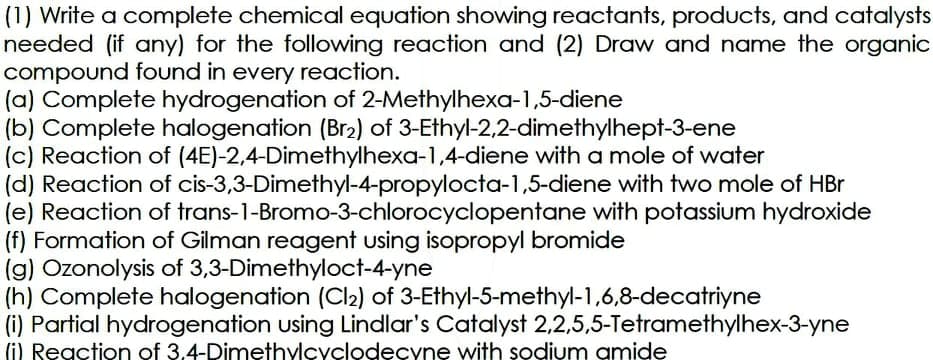(1) Write a complete chemical equation showing reactants, products, and catalys needed (if any) for the following reaction and (2) Draw and name the organi compound found in every reaction. (a) Complete hydrogenation of 2-Methylhexa-1,5-diene (b) Complete halogenation (Br2) of 3-Ethyl-2,2-dimethylhept-3-ene (c) Reaction of (4E)-2,4-Dimethylhexa-1,4-diene with a mole of water (d) Reaction of cis-3,3-Dimethyl-4-propylocta-1,5-diene with two mole of HBr (e) Reaction of trans-1-Bromo-3-chlorocyclopentane with potassium hydroxide (f) Formation of Gilman reagent using isopropyl bromide (g) Ozonolysis of 3,3-Dimethyloct-4-yne (h) Complete halogenation (Cl2) of 3-Ethyl-5-methyl-1,6,8-decatriyne (i) Partial hydrogenation using Lindlar's Catalyst 2,2,5,5-Tetramethylhex-3-yne (i) Reaction of 3,4-Dimethylcyclodecyne with sodium amide
(1) Write a complete chemical equation showing reactants, products, and catalys needed (if any) for the following reaction and (2) Draw and name the organi compound found in every reaction. (a) Complete hydrogenation of 2-Methylhexa-1,5-diene (b) Complete halogenation (Br2) of 3-Ethyl-2,2-dimethylhept-3-ene (c) Reaction of (4E)-2,4-Dimethylhexa-1,4-diene with a mole of water (d) Reaction of cis-3,3-Dimethyl-4-propylocta-1,5-diene with two mole of HBr (e) Reaction of trans-1-Bromo-3-chlorocyclopentane with potassium hydroxide (f) Formation of Gilman reagent using isopropyl bromide (g) Ozonolysis of 3,3-Dimethyloct-4-yne (h) Complete halogenation (Cl2) of 3-Ethyl-5-methyl-1,6,8-decatriyne (i) Partial hydrogenation using Lindlar's Catalyst 2,2,5,5-Tetramethylhex-3-yne (i) Reaction of 3,4-Dimethylcyclodecyne with sodium amide
Chemistry: The Molecular Science
5th Edition
ISBN:9781285199047
Author:John W. Moore, Conrad L. Stanitski
Publisher:John W. Moore, Conrad L. Stanitski
Chapter6: Covalent Bonding
Section: Chapter Questions
Problem 24QRT
Related questions
Question
100%

Transcribed Image Text:(1) Write a complete chemical equation showing reactants, products, and catalysts
needed (if any) for the following reaction and (2) Draw and name the organic
compound found in every reaction.
(a) Complete hydrogenation of 2-Methylhexa-1,5-diene
(b) Complete halogenation (Br2) of 3-Ethyl-2,2-dimethylhept-3-ene
(c) Reaction of (4E)-2.4-Dimethylhexa-1,4-diene with a mole of water
(d) Reaction of cis-3,3-Dimethyl-4-propylocta-1,5-diene with two mole of HBr
(e) Reaction of trans-1-Bromo-3-chlorocyclopentane with potassium hydroxide
(f) Formation of Gilman reagent using isopropyl bromide
(g) Ozonolysis of 3,3-Dimethyloct-4-yne
(h) Complete halogenation (Cl2) of 3-Ethyl-5-methyl-1,6,8-decatriyne
(i) Partial hydrogenation using Lindlar's Catalyst 2,2,5,5-Tetramethylhex-3-yne
(i) Reaction of 3.4-Dimethylcyclodecyne with sodium amide
Expert Solution
This question has been solved!
Explore an expertly crafted, step-by-step solution for a thorough understanding of key concepts.
This is a popular solution!
Trending now
This is a popular solution!
Step by step
Solved in 2 steps with 6 images

Knowledge Booster
Learn more about
Need a deep-dive on the concept behind this application? Look no further. Learn more about this topic, chemistry and related others by exploring similar questions and additional content below.Recommended textbooks for you

Chemistry: The Molecular Science
Chemistry
ISBN:
9781285199047
Author:
John W. Moore, Conrad L. Stanitski
Publisher:
Cengage Learning


Chemistry: The Molecular Science
Chemistry
ISBN:
9781285199047
Author:
John W. Moore, Conrad L. Stanitski
Publisher:
Cengage Learning
